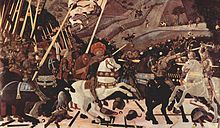Niccolò da Tolentino
Niccolò da Tolentino ( Niccolò Maruzzi della Stacciola ; * around 1355 in Tolentino ; † March 20, 1435 in Borgo Val di Taro ) was a condottiere .
He came from the Mauruzzi della Stacciola family from Tolentino. From 1370 onwards, alienated from his parents, he entered the service of various masters. In 1406 he was condottiere under Gabrino Fondulo, lord of Cremona . Pandolfo Malatesta III. († 1427), Lord of Fano and Cesena , made him his seneschal in 1407 and marshal in 1423 . Documents from the Biblioteca Universitaria of Urbino attest to his appointment as feudal lord in 1412 by Malatesta. This made him hereditary count and lord of the castle of Stacciola . In 1431 Pope Eugene IV confirmed the appointment.
He changed masters frequently. He was leader of the Florentine Army from June 1423 to May 1424, after which he moved to the papal troops until July 1424, to which he returned in August 1428 after his return to Florence. In 1431 it was Milan from February to August . In 1432 there was another move from the Vatican to Florence, which cost him the fief of Borgo San Sepolcro he had received the previous year. On June 23, 1433 he became the chief military leader of the Florentines.
He was captured by the Milanese and died as a result of a fall, possibly from outside influences. His considerable fortune at that time was 200,000 ducats , 2,000 pounds of silver , 90 horses and 30 donkeys . He is buried in the Duomo of Florence , his heart is kept in the Augustinian monastery in Tolentino.
Representations
In 1456 Andrea del Castagno made an equestrian fresco by Niccolò in the cathedral of Florence . Paolo Uccello painted it according to his ideas of the Battle of San Romano. Niccolò Machiavelli tells in his story of Florence (5th volume, 1st chapter) of Niccolò da Tolentino's capture and death.
Web links
| personal data | |
|---|---|
| SURNAME | Tolentino, Niccolò there |
| ALTERNATIVE NAMES | Maruzzi della Stacciola, Niccolò |
| BRIEF DESCRIPTION | Condottiere |
| DATE OF BIRTH | around 1355 |
| PLACE OF BIRTH | Tolentino |
| DATE OF DEATH | March 20, 1435 |
| Place of death | Borgo Val di Taro |

